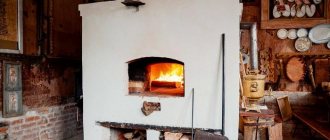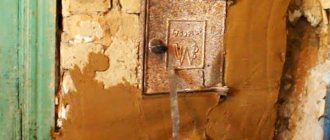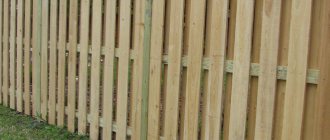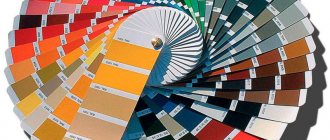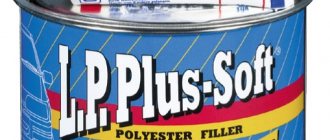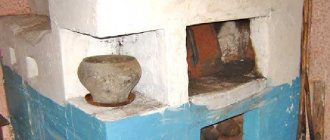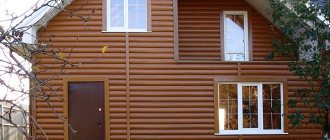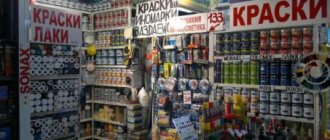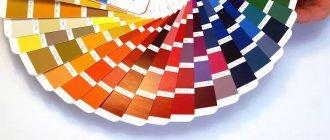Choosing a material for painting a brick oven
A Russian brick stove, built according to all the rules, releases half the heat generated by it into the room.
However, this amount directly depends on the material covering its surface. Moreover, a rough surface gives off more heat than a smooth one. Since ancient times, stoves in villages were painted with lime. The owners of rich houses decorated their stoves with tiles, turning them into real works of art. Nowadays, the best design for a brick stove is also its painting. But what is the best way to paint a brick stove?
The amount of heat that a brick stove gives to the house also depends on the material with which the stove is painted.
Painting with chalk or lime
A brick stove or fireplace made of bricks can be painted with lime whitewash. Its consistency should resemble liquid sour cream. Before painting the stove, it is necessary to carry out preparatory work: clean the surface of the stove from dust, dirt and clay. This can be done using a scraper or an iron spatula. Residues should be brushed off. For 100 g of lime you should take 35-40 g of salt dissolved in water. The paint obtained in this way is highly durable. If you paint a surface with it, it leaves no marks.
You can also paint a brick stove with chalk, which should first be sifted through a sieve, diluted with skim milk and stirred thoroughly. If the resulting solution has a yellow tint, you can add a little blue to it.
Before painting the surface of the stove, it must be moistened with water. This solution is applied in a very thin layer 2-3 times. Moreover, the next layer is applied to the well-dried previous one.
How to choose the right painting material
If the fireplace is used only as room decoration or is completely fake, it can be painted with almost any interior paint of a suitable shade. When purchasing material for structures used for its intended purpose, you will have to pay closer attention to the choice of paint.
For painting heated surfaces, heat-resistant paints and varnishes are suitable, which are not afraid of exposure to heat, fire and temperature changes. Ordinary paints will crack and fall off literally from the first stages of use. Organosilicon coatings are considered an ideal option for fireplaces: they are suitable for all types of outdoor and indoor stoves, heat generators, they last a long time, are elastic, and are aesthetically pleasing. The only disadvantage of such paints is the high price.
Heat-resistant paint for stoves and fireplaces GOLexpert
Heat-resistant acrylic paints, which can be tinted in any shade, are somewhat cheaper. A durable film will be created on the surface of the masonry, protecting it from destruction. If aluminum powder is added to the paint, it will withstand temperatures up to +500 degrees.
Alkyd and pentaphthalic coatings are also suitable for painting fireplaces, as well as heating metal elements. Unfortunately, they have such a strong odor that the room will need to be ventilated for a long time. It is better not to use oil paints for fireplaces - they will quickly darken after heating.
Other Painting Tips
An important point in the work is the correct choice of color of the coloring material. Firstly, you need to select a shade in accordance with the design idea so that it fits perfectly into the new interior. Secondly, it is necessary to take into account the heat transfer of the entire structure: the darker the color, the more intense this process will occur. You should make sure that the composition is exactly suitable for heat generators and does not emit harmful compounds when heated, and is environmentally friendly.
Painting a fireplace black
If you don’t have the financial means to purchase paint, you can use the following tips:
- Whitewash the fireplace. If such a design fits into the updated interior of the room, the idea can be adopted. 100 g of lime and 40 g of salt are diluted with water until a mass with a creamy texture is obtained. This mixture is applied to surfaces like paint using a brush or roller.
- Treat the structure with chalk. To dilute chalk, you can use water or skim milk (the latter option is considered more effective). Crushed powdered chalk is dissolved, the product is mixed and the fireplace is painted. If desired, add a little blue to the “paint”.
- Paint with an inexpensive homemade compound. To update the color of brickwork, take a brick or its scrap and pound it until flour is obtained. Separately combine milk and thickly beaten egg whites, mix with brick powder and paint the fireplace. The finished paint will be heat resistant and will last for many years. To make the surface matte, after paintwork it can be coated with drying oil.
Decorative whitewashing of the fireplace
Paints for brick kilns and methods of their use
The main criterion when choosing paint for a brick oven is its heat resistance.
A finishing method such as painting a brick stove with oil or enamel paints will allow it to emit a large amount of heat. The darker the paint color, the more heat the surface of the brick oven can give off. Moreover, it is known that shiny smooth surfaces have worse heat transfer. When choosing how to paint a brick stove, you should not paint it with aluminum paints and the like. If the thickness of the walls of the furnace hearth meets certain standards, its outer side can reach a temperature of 80°C. Synthetic compounds such as nitro paints, pentaphthalic paints and many others can withstand such heating. Oil paints made from drying oil, if used to paint the surface of a stove, may darken at this temperature.
Today, construction stores sell paints for a brick stove or fireplace that have high heat resistance. However, their color range is quite scarce. If the required shade still cannot be found, the brick oven can be treated with a special primer and painted with latex paint.
Before purchasing the paint required for your brick kiln, you should ensure that it is heat resistant. For this purpose, the best option is to use silicon-organic enamel. After all, it is capable of maintaining its performance qualities at temperatures up to 600°C. As a solvent for this type of enamels, either turpentine or solvent 646 is used. To get a good result, a brick stove should be painted in a thin layer without smudges in 2-3 approaches.
Popular paint brands
Suitable paint for metal and brick for fireplaces is a silicon-containing mixture KO-168, 8101, 813. These products have all the characteristics. There must be a mark on the packaging that the mixture is heat-resistant. 646 solvent or turpentine is used as a solvent. Brick surfaces are coated in two thin layers.
Another option is Certa anti-corrosion heat-resistant paints. The materials can be used for metal for stoves and fireplaces, as well as for brick. The compositions are sold in cans and cans. Assortment of colors - 12. By mixing primary colors, you can get interesting shades up to gray.
How to paint a red brick stove without spoiling the noble color? For this purpose, Elcon silicone varnish is chosen. It is able to withstand temperatures up to 250 degrees.
The NEW TON mixture is well suited for metal fireplaces. The composition can withstand temperatures up to 600 degrees. This product protects the metal from corrosion, has good elasticity, therefore it maintains the appearance of the surface and will not crack or deform when exposed to high temperatures.
Sometimes a surface painted with high-temperature paint needs additional processing. This is done on the basis of colorless varnishes KO-815 and KO-85. They are used to make heat-resistant enamels KO-813, which are suitable for metal and brick.
Brick stove in a modern interior
A brick stove can easily fit into the most modern interior design and even become its “highlight”.
Today, interiors designed in chalet, country, and shabby chic styles are extremely popular among homeowners. Their distinctive feature is the naturalization of various details and decorative elements. A Russian brick stove or fireplace would fit perfectly into such interiors as a bright and stylish addition. These items can be a real highlight. To do this, they can simply be painted with transparent paint. However, before painting the surface, it must be properly prepared. If there are any visible defects on it, they need to be eliminated by filling with putty. The latter is prepared by mixing latex paint and brick flour.
How to make your own brick paint
You can achieve a beautiful shade of a brick oven yourself by making your own paint. First, red brick flour is rubbed. Whipped egg whites and milk are added to it until thick. The mixture is thoroughly mixed. You need to paint the stove with a new brush, applying the paint to the surface of the stove that has been preheated to a warm state. In this case, the brick surface acquires an even red color. This coating is heat-resistant and has increased abrasion resistance. Finally, the stove must be painted with drying oil, which will make the dark red surface matte. If desired, you can get shine by using a special synthetic varnish.
This type of painting of a brick oven is approved by experts. After all, the resulting dense, rough surface promotes the greatest transfer of heat into the room and, having excellent elasticity, prevents the formation of cracks and various defects.
When faced with the choice of how to paint a brick oven, you can use another method of preparing paint for a brick oven. All that is required for this is turpentine and PF-283 varnish. Both components are mixed in equal proportions. The result is a transparent, slightly matte mixture. In order to give it the desired shade, you can proceed as follows: gouache of a certain color is well dried and ground into a fine powder, which is added to the prepared mixture. The paint is ready for use.
Fireplace decorating techniques
To stylize the design, you can use a technique such as highlighting the seams. The fact is that masked seams look uninteresting, while highlighted seams look unusual and creative. For standard brick-colored masonry, sandy, yellowish or white paints are usually used, which are applied to the seams using a thin brush. If there is no paint, mix turpentine and varnish in equal proportions, add a drop of gouache and use the composition in the same way.
You can also decorate the fireplace in other ways:
- paint a pattern on the front surface of the building;
- make a drawing using a stencil;
- paint metal elements in a contrasting color;
- create an imitation of wear and aging on the surface of the masonry (for example, make translucent strokes with lighter paint).
Contrasting design
There is no need to be afraid of experiments. Even with your own hands, you can completely transform an old fireplace and turn a banal design into a chic and sophisticated interior decoration.
Advantages and disadvantages of heat-resistant paint
Heat-resistant paint used for painting a brick oven has a number of advantages. The surface treated with it acquires certain properties: wear resistance, heat resistance, electrical insulation. It protects the brickwork from oxidation, contributes to its strength and durability. Painting the stove is quite easy and does not require prior application of primer. The paint retains its performance qualities for ten years.
The disadvantages of heat-resistant paints include an aggressive chemical composition and an unpleasant odor. They have a long drying time. When working with such paints, precautions should be taken due to the presence of toxic substances in their composition.
Why are stoves and fireplaces painted?
By painting fireplace heating devices, the following problems can be solved:
- Protect the surface from household pollution, and clothing from traces of brick dust.
- Simplify your daily care process. Paint allows you to achieve an attractive appearance of the treated surface and maintain its cleanliness without the use of special detergents - just wipe it with a damp cloth.
- Improve the decorative qualities of the fireplace and stove in the room.
- Design the heating device in accordance with the existing interior.
- Prevent the appearance of cracks in the brick and an increase in the size of existing defects. By using heat-resistant paint, it is possible to achieve a smooth surface.
- Improve heat transfer.
Properly selected paint makes it possible to hide defects and improve the aesthetics of a fireplace or stove
Paint for fireplaces and stoves - choosing the “right” paint
If you wish, you can make a stove or fireplace yourself, but in this case the question often arises of how to refine the hearth. The easiest way is to simply paint it with heat-resistant paint for fireplaces and stoves. But in order for the structure to retain its beautiful appearance for a long time, as in the photo, you need to choose the right way to paint the fireplace.
Preferred Brands
The market for modern finishing and paintwork materials is quite wide, and in order to choose the right coating suitable for fireplaces and stoves, you need to take into account many nuances.
The most famous and popular varnishes that can be used to coat a brick oven are: KO-85, KO-815 and Siltek-1. The presented materials have long held leading positions in their segments and have many advantages.
- KO-85. First of all, a store consultant will always recommend heat-resistant varnish KO-85. It can be used not only at the household level, but also to cover the surfaces of industrial equipment. A characteristic feature of the material is that it can easily withstand temperatures of 300°C degrees. Moreover, the unique composition can easily tolerate temperature fluctuations in a brick oven, even if the thermometer needle drops below -30°C degrees. Another nuance is the possibility of applying varnish using a spray bottle, which speeds up the surface treatment process, and the consistency of the liquid itself can be adjusted when diluted.
Varnish label KO-85
- KO-815. When using heat-resistant varnish KO-815, you don’t have to worry if temperature changes from 60 to 300°C are observed on the stove. Thanks to the high-quality composition, the coating is applied perfectly and is not overused, which allows you to significantly save on the purchase of material. Moreover, the presented coating can be safely used for application to those fireplace surfaces that have direct contact with the flame. The only inconvenience is that you can only work with varnish using the hot method. This means that hardening of the surface will occur only under certain conditions, which include heating the surface with infrared radiation.
Heat-resistant composition KO-815
- Siltek-1. The material called Siltek-1 allows the master to work with the surface of the furnace without first covering it with a special primer solution. Although in this case it is worth considering that when obtaining a fairly aesthetic result, a lot of material is consumed. The fact is that in order for the stove luggage to look beautiful and aesthetically pleasing, and also to be resistant to deformation, you need to apply at least 3 layers of varnish.
Good to know: What should be the height of the firebox in the furnace, we study the dependence on the type of fuel
Features of heat-resistant paint for stoves and fireplaces
The stove is a structure made of bricks and stones, to which elements made of cast iron (doors, curtains, frames, covers and other elements) are added. If you wish, you can paint the entire hearth, but the choice of paint must be approached responsibly. For example, many of them indicate what materials they are suitable for. But this needs to be checked by clarifying the composition and properties of the paint. You probably won’t be able to get by with just one can, since the materials used to lay the stove have different structures, which means that the requirements for the coloring composition will be different.
Any varnish for a brick stove contains silicone or silicon. Paint for fireplaces and stoves must withstand temperatures up to 600 degrees, but some manufacturers claim that their compositions do not lose their properties even at 700 degrees. These indicators are quite suitable, since the combustion temperature of wood is 300 degrees. Only coal is capable of heating up to a temperature of 900 degrees, but it will only be observed on the surface of the material, and much less heat is transferred to the walls of the furnace. For this reason, it is important to study the composition of the paints, because it will be necessary to use several solutions at once to paint several different parts of the structure.
If the fireplace is located outdoors, then it is necessary to use paint with high anti-corrosion properties - this will prevent the appearance of rust due to exposure to moisture. However, it must be taken into account that products for concrete and metal contain different components. You can also use universal thermal paint, which can be used to coat various materials. It forms a thin film on their surface that protects them from moisture, air and other factors that lead to rust.
Which paint is better to choose for a stove or fireplace?
To ensure that the paint retains its decorative qualities when exposed to high temperatures, special heat-resistant enamels are produced. They are designed not only to give the structure the required design, protect the surface from persistent penetration of dust and dirt into the bricks, but also from high humidity, and they will protect metal elements from oxidative processes and corrosion. Basically, all heat-resistant coatings are produced in the form of a suspension, and heat-resistant varnishes containing silicon and silicone act as the base.
Heat-resistant Cetra Enamel (up to 600 degrees)
Heat-resistant paints are available in cans or in the form of a spray in spray bottles. When painting stone surfaces, the paint is absorbed into the porous structure of the brick and forms a thin film on them, which becomes a protective coating.
In addition to their inherent protective qualities, heat-resistant enamels give the structures of stoves and fireplaces a special decorativeness and elegance - their walls become brighter and more aesthetically pleasing.
What are heat-resistant paints for?
Thermal paints are able to protect materials at high temperatures. Organosilicon-based compositions are good. They are also used when painting heat exchange equipment or heating equipment, the temperature of which is higher than that of the furnace walls.
The properties of paints can change when different components are added to them. For example, organic resin increases the drying time of the product, thereby increasing its elasticity and the degree of adhesion to the walls of the lesions.
The properties of paints are significantly influenced by aluminum powder - thanks to this component, the product can withstand temperatures of 600 degrees. Such materials serve not only for decoration, but also to increase the functionality of the stoves, promoting a smooth temperature distribution throughout the structure, thereby avoiding overheating. This is especially important for metal welds that begin to melt when exposed to heat. In addition, the paint serves as protection against released salt solutions, petroleum products, as well as high humidity, while maintaining vapor permeability.
Applying paint
Painting fireplaces requires preparation, just like any other construction work. First you need to make sure that you have purchased exactly the composition you need.
You also need to prepare the following tools:
- soft cloth;
- sandpaper;
- water;
- brush;
- roller;
- copper sulfate solution;
- sulfuric acid solution;
- spray.
First, prepare the surface that will be painted. It is cleaned of dust and dirt. Metal parts are cleaned with fine sandpaper. Be sure to remove greasy stains with a soft cloth soaked in a solution of water and salt. Soot can be easily removed with a solution of hydrochloric acid, and rust with a 10% mixture of copper sulfate.
It is recommended to apply the paint to a slightly warm surface using a brush, roller or spray - whichever is more convenient. In total, you need to make 2-3 layers, each of them should be allowed to dry thoroughly before applying the next one. The fireplace must be allowed to dry for several days; it cannot be used until the paint has completely hardened.
Painting technology
First of all, prepare the base. Be sure to wipe off all existing efflorescence - thoroughly clean the masonry using a metal brush. The brick is not wetted with water, since it cannot wash away the efflorescence completely. The old paint is also cleaned off without any residue, the soot is wiped off with a solution of hydrochloric acid.
The area around the cracks is treated with a scraper, all crumbling particles are removed. Defects are covered with heat-resistant putty. Damaged seams are unstitched and re-sealed, and attempts are made to replace broken bricks with new ones. Old fireplaces are completely treated with a lime-clay mixture in 2 layers and sanded. At the end of the work, dust is brushed off, a special primer is applied and the fireplace is heated.
Before staining, the selected material is mixed. The two-component compositions are combined and shaken thoroughly. Add color in the required quantity. They start work only at above-zero temperatures in the house and at normal air humidity. The paint is applied with a brush, roller or compressor, which is most convenient and quick. After the first layer has dried, apply the next one, and so on for at least 2-3 layers. Do not light the fireplace for 4 days, and then begin its full operation.
Applying paint to metal surfaces
First, the metal elements are cleaned with sandpaper, and the walls of the fireplace are cleaned of dust with a damp cloth. Metal dampers are treated with a 5% sulfuric acid solution and a bristle brush. It is necessary to wear gloves when working with acid. The remaining composition is washed off with a soap solution - first with a cloth, and then with a rag.
Painting the fireplace occurs after it is heated to 150 degrees. Then, within one and a half hours, apply a solution of sodium hydroxide (50 g/l) using a sprayer. Then the fireplace should stand for a couple of days. When applying paint to a warm surface, do not use a brush. If the hearth is not built very correctly (for example, the masonry is uneven), then the surface must be plastered with lime-gypsum mortar in several layers, after preheating the oven to 150 degrees.
When painting, it is important to remember the safety rules: work with gloves and only in a well-ventilated area. It is also necessary to avoid contact of paint and other products with skin or eyes.
How to properly paint the surface of a stove or fireplace?
If you decide to change the appearance of the stove, and the appropriate paint is chosen for this, you can safely get to work. You need to start with preparatory measures - this is necessary so that the enamel lays flat, does not swell, and does not fall off after the first fire. And only after all the preparations can you start painting.
- All oven surfaces that are planned to be painted are freed from various types of dirt and dust. A cooking and heating stove requires a particularly careful approach, since there may be greasy and other types of stains. Deep greasy stains can be removed with baking soda and hot water. Dip a soft cloth in hot water and then in baking soda and apply it to the greasy stain. This action is repeated several times. After this, all cleaned parts should dry.
The oven is given a completely different look
- Cast iron elements are cleaned using a wire brush and then sandpaper. Next, they are wiped with a damp cloth and wiped dry.
- If rust on the metal cannot be removed, you can use a 10% solution of copper sulfate to remove it.
- Heat-resistant paint does not require a base coat on the surface in the form of a primer, and if the oven was previously coated with it, it must be removed.
- Before applying the enamel, it is better to heat the oven a little and let it cool to a warm state.
- After this, they proceed directly to painting. The enamel can be applied by brush, spray or roller.
Applying paint with a brush
- The stove is painted in several layers, each of which is applied after the previous one has completely dried. Painting is carried out in different ways and has different types. For example, it can be plain, plain or with the application of structural or textured patterns, wet and semi-dry, it can be applied from spray cans or a set of brushes of different calibers.
Don’t forget about the cast iron parts of the stove - they also need protection and decoration
- After painting and drying the paint, it is not recommended to heat the stove at full power - it is better to wait 2-3 days. If all the requirements specified in the instructions are met, then the stove or fireplace structure will delight the owner with its elegant appearance for ten to fifteen years.
All about red brick fireplaces: types and colors
The construction of fireplaces made of red brick immediately sets the room a certain style, approaching country or Provence. A deliberately rough structure with a relatively thick layer of binding mortar is also perfect for high rooms or living rooms. A well-built red brick fireplace in the interior immediately acquires a dominant position in the room.
In general, red brick is not considered an ideal material for building a real fireplace, since its heat resistance is inferior to white brick and is sensitive to shock loads. But thanks to its high decorative qualities and with skillful installation, it can significantly improve the interior of the room and even become the dominant center in the compositional solution. The red brick fireplace in the photo only confirms this position.
What you need to consider when deciding to build a home fireplace made of red brick:
Fireclay bricks are most suitable for building home fireplaces. Its high fire-resistant characteristics are due to the fact that up to 30% of fireclay bricks consist of coke powder or graphite. They give the final product the necessary strength and fire resistance.
However, in the case of laying a fireplace, additional requirements are usually put forward to fireclay bricks related to the need not only to withstand the high temperatures that develop during the operation of the fireplace insert, but also to store heat for a long time in the walls of the fireplace body.
In this regard, the following types of red fireclay bricks are used:
A common disadvantage of all types of fireclay bricks is their low decorative value - the abundance of orange and bright red shades of such bricks is not always acceptable in the interior of a house. All bricks intended for the construction of a fireplace must be carefully checked, and products with surface cracks must be rejected.
When building home fireplaces, fireclay bricks are laid on a high-temperature solution, which is a clay-fireclay mixture prepared with fine fireclay chips. Since red brick has a fairly high coefficient of thermal expansion, the seams are always made slightly larger - up to 4 mm. In this case, open fireplace inserts will look very stylish and will be able to last for decades without repair.
What paints to use
The principle of operation of the furnace.
Decorative qualities are of great importance, but some features should be taken into account. For example, a shiny surface is much less able to transfer heat. In this regard, it is better to refuse to cover the stove with glossy paints, for example, aluminum. If the stove is built taking into account all the rules, and there is sufficient thickness of the walls of the fireplace, then the heating of the outer side can reach 80 degrees. This temperature is maintained by many synthetic compounds. These include pentaphthalic paints, nitro paints and others.
Modern oven design
In the modern design of a fireplace and stove, designers attach great importance to color schemes. In addition, trends now prevail that are aimed at naturalizing the elements and details that make up the interior. One of the most stylish elements is the fireplace, as well as the Russian stove. Rustic styles, such as Provence and country, are extremely popular nowadays. For fans of these styles, there is the opportunity to make a Russian stove a real masterpiece, and the fireplace will perfectly complement the interior. What does this require?
You can use clear paint and you will be sure to add a unique element to your home. Before you start painting a brick oven in this way, you need to prepare it appropriately, that is, give it an aesthetic appearance. If the outer surface has dents, potholes and other defects are found, then they need to be filled with putty. To make your own putty, you will need to take latex paint and add brick flour to it.
Treating the stove surface before painting
Diagram of the spray gun device.
How is the surface of the stove that you are going to paint reanimated? For this purpose, an ordinary red brick is taken and flour is rubbed from it. Add 10 pre-beaten egg whites and milk to the resulting powder. The resulting mass should have the consistency of thick sour cream. The mixture should be applied with a brush to the surface of the oven while it is still warm. The entire outer surface can be treated with a similar composition. It will have a smooth red color. In addition, the applied layer has qualities such as resistance to abrasion and heat.
The next step in the process of restoring a stove or fireplace is to coat the surface with drying oil, which achieves a beautiful dark red hue. You should know that the surface treated in this way will be matte. If you want shine, use synthetic or oil-based varnishes. The presence of a shiny surface is ensured by painting with latex paint. Experts widely recommend this type, since the surface has sufficient density and roughness, which provides good heat radiation.
Features of varnish coating
Yes, the process of building a high-quality stone stove in a house is quite complicated. However, no less attention should be paid to the moment of cladding the structure. It is very important that the heating device fits into the interior of the room as much as possible. This will help create additional comfort and coziness. Some people use finishing materials for this, while professionals go further and coat the surfaces of the stoves with varnish.
The peculiarity of brick is that it does not deform for many years, while being resistant to high temperatures. Regardless of the type of fireplace structure, its surface will heat up, filling the room with a comfortable temperature.
Taking these characteristics into account, manufacturers offer a special varnish for brick ovens, which differs significantly from the standard material. Those homeowners who have tried to open the surface of a structure with ordinary paint or varnish know firsthand how quickly the material loses its primary properties.
Good to know: Which brick oven is the best and most economical
Today, various modern technologies are used in the production of topcoat varnish for surfaces that emit high temperatures. Among the constituent components of the material, you can find organosilicon elements that have the ability to dissolve in an oil environment, as well as a special impregnation, which gives the varnish the appropriate properties.
Presentable looking brick building
The difference between heat-resistant varnishes and regular ones is as follows:
- The level of grip increases.
- The material dries quite quickly.
- No film is formed that will peel off in the future.
- Increased level of resistance to heat.
- Deep penetration into the porous structure of the brick.
Experts in the construction of stoves also note that fireplace varnish dries very quickly, and the higher the temperature, the less time it will take. The first layer of material at 18°C in the room will dry out after 60 minutes. Thanks to this, a sufficient number of layers of material can be applied in one day of light.
Brickwork coated with a protective compound
The presented material is classified as heat-resistant. To confirm this, it should be noted that the temperature the varnish can withstand without losing its original qualities can reach 250°C degrees.
It should be noted that heat-resistant varnish must be applied to the structure to reduce the level of mechanical friction.
The most spectacular colors for a fireplace
Equipment for powder painting of the furnace.
Although the surface of a brick oven is quite dense, after drying latex paint retains its elasticity, preventing cracks from occurring. A fireplace in a private home or country house, like a stove, is a striking element of the interior. Therefore, painting or plastering these structures requires maximum responsibility. If high-quality brick was used in the construction of the fireplace, then when painting it is much easier to emphasize the beauty of the material. According to experts, paint that imitates the color of old brick looks excellent. In this case, it can be various shades of red and crimson.
If you are painting a fireplace, silicone paints are suitable. Aerosol paints are especially convenient. To dilute silicone paints, solvent 646 or turpentine is used. To correct the color to the desired shade, you can add dry gouache. To do this, liquid gouache is pre-dried and then ground into a fine, homogeneous powder. In order for the fireplace to be painted to a high quality, it requires several layers of coating. At the same time, it should be remembered that the layers must be thin and applied evenly. Otherwise, smudges and flaws may occur that will spoil all your work.
Features of stove painting
Powder painting technology.
To ensure the most decorative appearance of the stove, you can paint the seams between the bricks in a light tone. For example, sandy, yellowish and even white shades work well. You can use a composition such as a mixture of turpentine and PF-283 varnish in a one-to-one ratio. The coating is transparent and matte. If you add dry gouache of the required color to the mixture, you can easily get paint. If the fireplace is made of poor quality brick, the masonry is done carelessly or there are significant flaws, plastering is done with lime-gypsum or lime-clay mortar.
Before painting, stoves and fireplaces are thoroughly cleaned, and the seams are deepened by approximately 7 mm. The oven must first be heated so that the surface is slightly warm. The next step is to wet the surface with water. The solution is applied in two layers. It is assumed that the first layer is liquid, with grouting. The thickness of the plaster, including two layers, should be no more than 10 mm. After application, the surface is thoroughly leveled and rubbed. When the plaster is completely dry, all existing cracks are sealed and rubbed with mortar. It is necessary that the plaster layer is monolithic and uniform.
Further processing of plastered fireplaces and stoves
To ensure high-quality painting of the plastered surface, the applied layer is treated with coarse sandpaper, which is fixed to a block. Next comes sanding. For this purpose, you can use a swab made of washcloth, or a rag made of coarse burlap will also work.
After such preparation, the stove is ready for painting with various compositions. If you decide to paint the fireplace, you can make the paint for this purpose yourself. Select the gouache of the desired color, dilute it in a liter jar, add egg white to it. The mixture should have a homogeneous mass.
Where to start painting
Powder painting technology.
To ensure the most decorative appearance of the stove, you can paint the seams between the bricks in a light tone. For example, sandy, yellowish and even white shades work well. You can use a composition such as a mixture of turpentine and PF-283 varnish in a one-to-one ratio. The coating is transparent and matte.
Before painting, stoves and fireplaces are thoroughly cleaned, and the seams are deepened by approximately 7 mm. The oven must first be heated so that the surface is slightly warm. The next step is to wet the surface with water. The solution is applied in two layers. It is assumed that the first layer is liquid, with grouting.
To ensure high-quality painting of the plastered surface, the applied layer is treated with coarse sandpaper, which is fixed to a block. Next comes sanding. For this purpose, you can use a swab made of washcloth, or a rag made of coarse burlap will also work.
After such preparation, the stove is ready for painting with various compositions. If you decide to paint the fireplace, you can make the paint for this purpose yourself. Select the gouache of the desired color, dilute it in a liter jar, add egg white to it. The mixture should have a homogeneous mass.
Before painting, stoves and fireplaces are thoroughly cleaned, and the seams are deepened by approximately 7 mm. The oven must first be heated so that the surface is slightly warm. The next step is to wet the surface with water. The solution is applied in two layers. It is assumed that the first layer is liquid, with grouting.
Palette of colors

